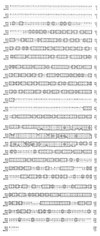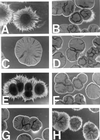COS1, a two-component histidine kinase that is involved in hyphal development in the opportunistic pathogen Candida albicans
- PMID: 9618540
- PMCID: PMC22741
- DOI: 10.1073/pnas.95.12.7069
COS1, a two-component histidine kinase that is involved in hyphal development in the opportunistic pathogen Candida albicans
Abstract
Two-component histidine kinases recently have been found in eukaryotic organisms including fungi, slime molds, and plants. We describe the identification of a gene, COS1, from the opportunistic pathogen Candida albicans by using a PCR-based screening strategy. The sequence of COS1 indicates that it encodes a homolog of the histidine kinase Nik-1 from the filamentous fungus Neurospora crassa. COS1 is also identical to a gene called CaNIK1 identified in C. albicans by low stringency hybridization using CaSLN1 as a probe [Nagahashi, S., Mio, T., Yamada-Okabe, T., Arisawa, M., Bussey, H. & Yamada-Okabe, H. (1998) Microbiol. 44, 425-432]. We assess the function of COS1/CaNIK1 by constructing a diploid deletion mutant. Mutants lacking both copies of COS1 appear normal when grown as yeast cells; however, they exhibit defective hyphal formation when placed on solid agar media, either in response to nutrient deprivation or serum. In constrast to the Deltanik-1 mutant, the Deltacos1/Deltacos1 mutant does not demonstrate deleterious effects when grown in media of high osmolarity; however both Deltanik-1 and Deltacos1/Deltacos1 mutants show defective hyphal formation. Thus, as predicted for Nik-1, Cos1p may be involved in some aspect of hyphal morphogenesis and may play a role in virulence properties of the organism.
Figures




References
Publication types
MeSH terms
Substances
Associated data
- Actions
Grants and funding
LinkOut - more resources
Full Text Sources
Other Literature Sources
Molecular Biology Databases
Miscellaneous

